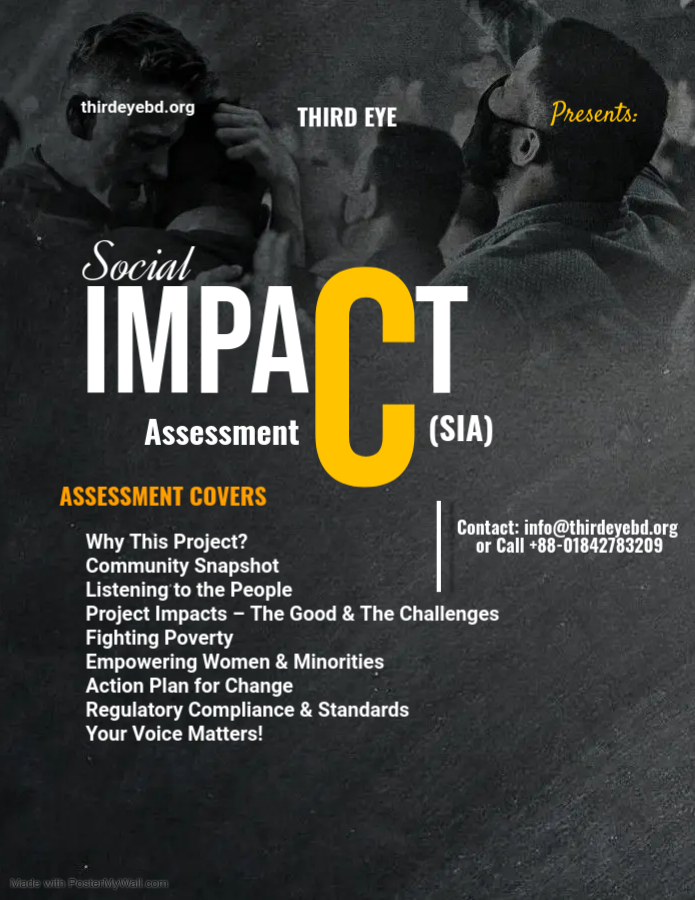Social Impact Assessment

A Social Impact Assessment (SIA) is a process used to identify and evaluate the potential social effects of a proposed project, program, or policy on communities and individuals. It involves assessing the likely impacts on various aspects such as health, culture, education, employment, and quality of life. SIAs aim to mitigate negative impacts and enhance positive ones, often involving stakeholders in the decision-making process. Here are some key areas typically examined in a Social Impact Assessment. Here's a general methodology and process for conducting a social impact assessment by which THIRD EYE will assist:
Define Scope and Objectives:
Clearly outline the purpose and objectives of the social impact assessment.
Define the scope, considering the specific industry, geographic area, and time frame.
Stakeholder Identification: Identify and engage with key stakeholders, including employees, local communities, suppliers, customers, regulatory bodies, NGOs, and other relevant parties.
Understand the concerns, interests, and expectations of each stakeholder group
Literature Review: Review existing literature, policies, and regulations related to social impacts in the specific industry.
Identify industry-specific benchmarks and best practices.
Data Collection: Gather quantitative and qualitative data on various aspects of the industry, such as employment conditions, economic contributions, environmental impact, community relations, and supply chain practices on Compliance Questions- Management Systems, Transparency and Traceability including Hiring and Termination and Supply Chain, Minimum Age, Child Labour and Young Workers, Forced Labour, Discrimination, Disciplinary practices, harassment and abuse, Freedom of association and grievance mechanism, Working hours and overtime, Remuneration and Benefits, Health and safety etc.
Utilize surveys, interviews, focus group discussions, and site visits as appropriate.
Impact Identification and Assessment: Identify potential social impacts associated with the industry's operations.
Assess the magnitude and significance of these impacts on stakeholders. Consider both positive and negative effects.
Baseline Assessment: Establish a baseline to compare current conditions with the situation before the implementation of the industry's operations.
Risk and Opportunity Assessment: Identify potential risks to social well-being and opportunities for positive impact.
Assess the likelihood and severity of these risks and opportunities.
Mitigation and Enhancement Strategies: Develop strategies to mitigate negative social impacts and enhance positive ones.
Prioritize actions based on their potential impact and feasibility.
Report and Communication: Compile the findings and recommendations into a comprehensive social impact assessment report.
Clearly communicate the results to stakeholders, ensuring transparency and accessibility.
Feedback and Iteration: Seek feedback from stakeholders on the assessment findings and proposed strategies.
Iterate the assessment process based on feedback and new information.
Monitoring and Evaluation: Establish a monitoring and evaluation framework to track the implementation of mitigation and enhancement strategies.
Regularly assess the effectiveness of measures and adjust them as needed.
Continuous Improvement: Commit to continuous improvement by incorporating lessons learned from the assessment into ongoing business practices.
Overall, social impact assessment is a crucial tool for promoting sustainable development, ensuring that proposed projects and activities contribute to positive social outcomes while minimizing harm to affected communities and stakeholders
For further inquirey, pls click on our customer inquiry form:
https://docs.google.com/forms/d/e/1FAIpQLSceazFa25VuB_y5v6PmzNbEPZpvMLU1a8Vou-ymUzwRqM0i8g/viewform
